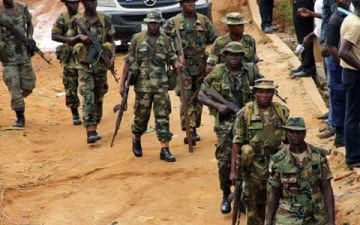
About 850 Nigerian soldiers on peacekeeping mission in
Liberia are to be quarantined for 28 days when they return to the country in
March 2015.
There are two battalions of the Nigerian Army in Liberia.
Investigations revealed that soldiers in one of the
battalions were drawn from the 331 Artillery Regiment, Kontagora.
A source said on Sunday that the Army personnel were
scheduled to return to the country in January but that their arrival would be
delayed till March 2015.
According to the source, when they arrive in the country in
March 2015, they will be quarantined in Gwagwalada, Abuja for 28 days before
being allowed to go to their formations.
It was gathered that the soldiers returning from a similar
mission in Sudan were not likely to be quarantined because Sudan had not
recorded any Ebola case.
The source said that the Army authorities decided to ensure
a painstaking observation of soldiers returning from Ebola infested countries because
of the danger posed by the disease.
The source said, “You know that our soldiers in Liberia are
to return to the country from two mission areas, Liberia and Sudan.
“The men of the Nigerian Army Battalion 43, in Sudan, will
arrive in the country in December, and may be allowed to go their units on
arrival in the country.
“But the arrival of their counterparts from Liberia, who
were initially supposed to arrive in the country in January, will be delayed.
The UN has not approved their movement so they will leave Liberia for Nigeria
in March.
“Another thing is that even when they arrive in the country,
they will be kept at a military barracks being built at Gwagwalada for 28 days
before they are released to go to their units.
“I think the authorities are just being careful; there is no
intent to demoralize anybody because we all know the dangers of this Ebola
Virus Disease.
“With the arrangement, only medical personnel would be
allowed access to them.
“You know that the World Health Organization has declared Nigeria
Ebola free so all efforts would be made to keep that status,” the source said.
The Head of the Nigerian Army Medical Corps, Major-General
Obashina Ogunbiyi, had said during a meeting of infectious diseases experts
under the aegis of the Ebola Treatment Research Group in Abuja on Thursday that
some Nigerian soldiers had been quarantined in Liberia following the death of a
Sudanese who went to their camp to pray with them.
The Sudanese was said to have died two days after the prayer
session and was believed to have died of the EVD.
The Ebola Virus Disease “has landed among our troops in
Liberia after the death of the Sudanese. The Sudanese entered the troops’ camp
to pray and two days later, he died. All troops were quarantined … We thought we were getting away but Ebola is still with us. Anyone
of those soldiers can come home on holiday,” Ogunbiyi reportedly said.
Also, the Defence Headquarters said in a tweet on its
twitter handle on Friday that “all necessary steps are being taken to ensure
that no Nigerian soldier is infected with the deadly virus while serving in
Liberia.”
The DHQ stated further in another tweet that the troops were
quarantined for “preventive purposes and medical observation following the case
of a Sudanese, a UN employee who was reported to have manifested … (the EVD).”
It was added that while no Nigerian soldier had shown
symptoms of the disease, they were still confined to their camp.
Investigations further revealed that the Federal Government
might not send troops to replace the two battalions in Liberia at the
expiration of their mission.
It was learnt that the remaining two battalions in Liberia
might not be replaced not necessarily because of the Ebola threat, “which
though is a coincidence, but because the mission is winding down.”
When our correspondent contacted the Director, Army Public
Relations, Brig. Gen Olajide Laleye, on the issue of the move to place
returning soldiers from Liberia under observation for 28 days, he said that the
Corps Commander Medical, Maj.- Gen Ogunbiyi, was the most competent person to
speak on the issue.
He advised our correspondent to wait for a statement from
Ogunbiyi on Monday.
Laleye said, “The Corps Commander, Medical Maj. Gen
Ogunbiyi, will make a statement on it on Monday; you are advised to wait for
the statement as I cannot comment on it.”
The Army spokesman also said issues relating to the
deployment or withdrawal of troops to Liberia could only be decided at the
policy level.
“The decision to send troops to Liberia was taken at the
national level and the decision not to send troops can only be taken at the
strategic level. I cannot comment on that,” he said.
Culled from Nepicity






